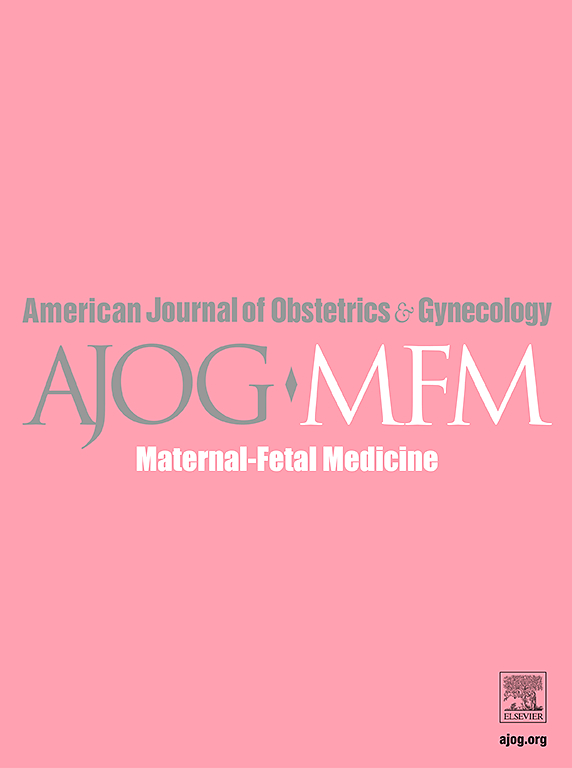Early wound dressing (soft gauze/tape dressing) removal after cesarean delivery: a meta-analysis of randomized trials
IF 3.1
2区 医学
Q1 OBSTETRICS & GYNECOLOGY
American Journal of Obstetrics & Gynecology Mfm
Pub Date : 2025-07-14
DOI:10.1016/j.ajogmf.2025.101739
引用次数: 0
Abstract
Objective
To assess whether removing the wound dressing within 24 hours after a cesarean delivery leads to any negative effects on wound healing and to recommend the best time for dressing removal.
Data sources
Science Direct, PubMed, Cochrane Library, and Scopus as the electronic databases from their inception until December 2024.
Criteria for study eligibility
Randomized controlled trials (RCTs) were incorporated in the databases, irrespective of their publication language, sample size, publication date, use of blinding, or study setting/location.
Study appraisal and synthesis methods
A systematic review of RCTs was conducted to compare wound outcomes in cesarean delivery patients with early dressing removal vs standard care. Utilizing an intent-to-treat approach, the analysis evaluated wound complication rates through both objective wound scores and subjective patient-reported complaints. The primary outcome of the study was postoperative wound complications, defined as any of the following: infection, disruption (skin dehiscence or deeper), or seroma/hematoma. The summary measures were reported as odds ratio (OR) or as mean difference with 95% of confidence interval (CI), using the random effects model of DerSimonian and Laird.
Results
Four trials, including 2130 participants, were included in the meta-analysis. Most of them defined early dressing removal as 24 hours after cesarean, and late removal as 48 hours after cesarean. All trials used soft gauze/tape dressing. Pooled data showed that early removal did not increase the incidence of wound complications (17.9% vs 19.4%; OR 0.90, 95% CI 0.72–1.14), and was associated with higher maternal satisfaction.
Conclusion
Early dressing removal (≤24 hours) after cesarean delivery appears to be safe and preferable compared to later removal, since it is associated with higher maternal satisfaction.
剖宫产后早期伤口敷料(软纱布/胶带敷料)去除:随机试验的荟萃分析:简短标题:剖宫产后早期伤口敷料去除。
目的:评价剖宫产术后24小时内拔除创面敷料是否对创面愈合有不良影响,并推荐最佳拔除敷料时间。数据来源:Science Direct, PubMed, Cochrane Library, Scopus作为电子数据库从成立到2024年12月。研究资格标准:随机对照试验(rct)纳入数据库,无论其发表语言、样本量、发表日期、使用盲法或研究环境/地点如何。研究评价和综合方法:对随机对照试验进行系统回顾,比较剖宫产患者早期脱敷料与标准护理的伤口结局。采用意向治疗方法,分析通过客观伤口评分和主观患者报告的投诉来评估伤口并发症发生率。该研究的主要结局是术后伤口并发症,定义为以下任何一种:感染、破裂(皮肤裂开或更深)或血肿/血肿。采用DerSimonian和Laird的随机效应模型,以比值比(OR)或95%置信区间(CI)的平均差(MD)报告总结测量结果。结果:四项试验,包括2130名参与者,被纳入meta分析。大多将早期拔除敷料定义为剖宫产后24小时,晚期拔除敷料定义为剖宫产后48小时。所有试验均使用软纱布/胶带包扎。汇总数据显示,早期拔除并未增加伤口并发症的发生率(17.9% vs 19.4%;OR 0.90, 95% CI 0.72至1.14),并与较高的产妇满意度相关。结论:剖宫产术后早期(≤24小时)拔除敷料是安全的,且较晚拔除敷料更为可取,因为其与更高的产妇满意度相关。普洛斯彼罗注册号:CRD42024523330。
本文章由计算机程序翻译,如有差异,请以英文原文为准。
求助全文
约1分钟内获得全文
求助全文
来源期刊

American Journal of Obstetrics & Gynecology Mfm
Medicine-Medicine (all)
CiteScore
7.40
自引率
3.20%
发文量
254
审稿时长
40 days
期刊介绍:
The American Journal of Obstetrics and Gynecology (AJOG) is a highly esteemed publication with two companion titles. One of these is the American Journal of Obstetrics and Gynecology Maternal-Fetal Medicine (AJOG MFM), which is dedicated to the latest research in the field of maternal-fetal medicine, specifically concerning high-risk pregnancies. The journal encompasses a wide range of topics, including:
Maternal Complications: It addresses significant studies that have the potential to change clinical practice regarding complications faced by pregnant women.
Fetal Complications: The journal covers prenatal diagnosis, ultrasound, and genetic issues related to the fetus, providing insights into the management and care of fetal health.
Prenatal Care: It discusses the best practices in prenatal care to ensure the health and well-being of both the mother and the unborn child.
Intrapartum Care: It provides guidance on the care provided during the childbirth process, which is critical for the safety of both mother and baby.
Postpartum Issues: The journal also tackles issues that arise after childbirth, focusing on the postpartum period and its implications for maternal health. AJOG MFM serves as a reliable forum for peer-reviewed research, with a preference for randomized trials and meta-analyses. The goal is to equip researchers and clinicians with the most current information and evidence-based strategies to effectively manage high-risk pregnancies and to provide the best possible care for mothers and their unborn children.
 求助内容:
求助内容: 应助结果提醒方式:
应助结果提醒方式:


